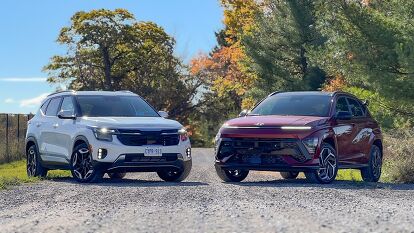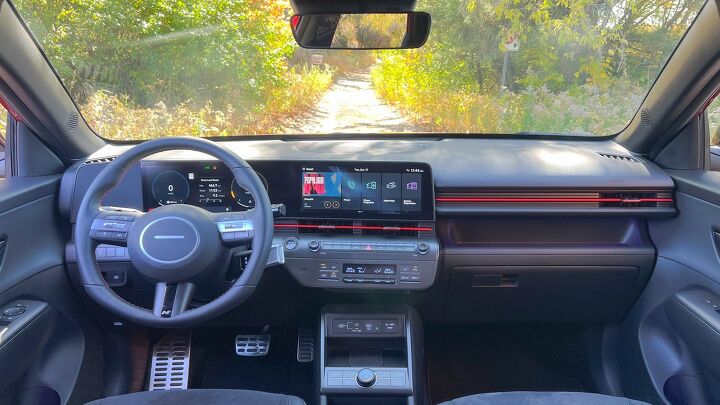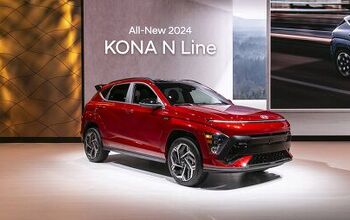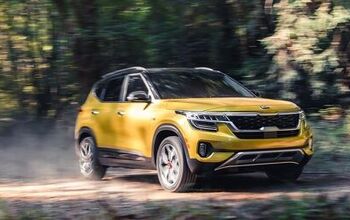Hyundai Kona vs Kia Seltos Comparison: Sub-Compact Siblings

Both Hyundai and Kia have spent the last few years breaking sales records and earning plaudits along the way.
What better segment for two of the most competitive brands to duke it out than the fastest-growing one?
The two brands took different approaches to the sub-compact SUV segment. The Kona was out the gate first, a pint-sized loveable weirdo that always felt like more of a hatchback on stilts. When Kia brought the Seltos to these shores a few years later, it anchored the lineup as a more rough-and-tumble SUV, offering heaps of space and tech for barely more money than the Soul.
Now they’ve more or less met in the middle: the Kona has an entirely new, much larger second generation, catching up to the Seltos in size. Meanwhile the Seltos saw a thorough facelift for ’24, modernizing its cabin and tweaking the top powertrain. We got them together for a quick comparison to figure out which most deserves your hard-earned.
Interior and Cargo Space
Hyundai Kona: The latest Kona sets a futuristic tone with its angular exterior styling, and that all-about-the-lines motif extends to the cabin. The Kona dashboard is a pleasantly simple affair with an emphasis on the horizontal, including the passenger-side cubby, in-line vents, and the strip of red running through the latter. Cabin materials are generally appropriate for the class, though the door panels can feel cheap. Crucially, Hyundai saves the good stuff for the high-traffic areas like the shifter and climate controls.
The Kona’s growth spurt affords it big-boy levels of passenger space. Headroom is the same 38.3 inches (973 millimeters) in both rows, and second-row legroom is now a very healthy 38.2 inches (970 mm). There’s also more natural light now too, though the boxier Seltos still has a slight advantage there.
Seat comfort is generally good, as the combo of leather and suede make for grippy and breathable thrones. The N Line loses points for the lack of power-adjustments however. On the flip side, its transmission tunnel bump is smaller, so should you be fitting three folks in the back, the middle person should be (slightly) more comfortable than they would be in the Seltos.
The Kona will swallow up a useful 25.5 cubic feet (722 liters) of stuff with the seats up. That’s about a square foot shy of the Seltos’ figure, though that gap switches in the Kona’s advantage for seats-down mode: 63.7 cubes against 62.8 (1,804 and 1,778 L, respectively).
Kia Seltos: The Seltos’ freshening tweaks bring it closer in line with the rest of the Kia SUV family. The lower section and center console are more or less untouched, other than some physical button rejiggery for the climate controls. The dashboard adopts a twin-screen setup and a contrasting soft-touch trim, which is a welcome splash of color. Kia’s fractal-like speaker covers continue to delight, though the armrests house some cheap-feeling plastic.
While it gives up about an inch of wheelbase, the Seltos still holds its own against its newer sibling. Cabin space is within a half-inch in nearly every measure, except front shoulder room (55.5 inches against Kona’s 56.8) and headroom (40.0 inches against Kona’s 38.3).
Seat comfort is great, with the brown leather seats looking and feeling fantastic—not to mention the power adjustability, plus heat and ventilation, the latter of which the Kona skips. Back-seat passengers get to enjoy as much space as some next-size-up SUVs, and the Seltos offers up heated outboard seats, something the Kona lacks.
Bottom Line: The Kia has the nicer seats for everyday use, and a more traditional cabin design. Space is pretty much a draw here, so it’s down to buyer’s tastes.
Hyundai Kona vs Kia Seltos: Tech and Features
Kona: The Kona’s infotainment system is the first Hyundai product to use the whole group’s new ccNC user interface. It’s quicker to respond and, at least in the Kona, pleasantly simple to use, keeping most every control within about two pokes. There’s also simply more real estate: twin 12.3-inch screens trump a pair of 10.25s.
That being said, the Kona can come off a little stingy after the loaded Seltos. The afore-mentioned lack of power seating is one example. Hyundai has also ditched the head-up display, and while you can get ventilated front seats on the top trim in the US and Canada (Limited and N Line Ultimate, respectively), there’s no way to get heated buns for the second-row folks.
Another big miss: a power-operated tailgate. This is something the Seltos offers, and while the Kona Limited has just that in the US, no trims offer one in Canada.
On the flip side, only the Kona offers an available 360-degree camera; not on this trim, however.
Seltos: The Seltos still runs the last-generation Kia user interface on its twin 10.25-inch screens. It remains a fine system to use, but is beginning to show its age, specifically with the poor legibility of its font.
The Seltos does offer up plenty of creature comforts to make up for that, however. Heated and ventilated seats are swell, and while its HUD uses the old pop-up glass approach, at least it offers one. The sound system is also better—though both respective top trims offer a Bose setup. It’s hard to ignore the usefulness of a power tailgate too, especially if you’re shorter.
Kia’s safety suite is just as robust as Hyundai’s—no surprise there—but the Seltos comes with Highway Drive Assist here; the Kona does not. Similarly, no Seltos trims come with a surround-view camera; only the Kona can. Both cars offer a digital key.
Bottom Line: As-equipped, the Seltos simply has more useful tech for the bustling family. It noses ahead here.
Powertrain, Driving Feel, and Efficiency
Kona: Both of these little cute-utes offer a 2.0-liter as standard, and a choice of front- or all-wheel drive. Both also offer—and in the case of this comparison, come equipped with—a 1.6-liter turbo-four with all-wheel drive. Hyundai will let you pair the turbo with front-drive, while Kia locks it to the torque-vectoring AWD setup. Both turbo setups now feature an eight-speed automatic transmission.
The Kona is rated slightly lower at 190 horsepower and 195 pound-feet. All other things being equal, it’s unlikely the five ponies would go noticed. However, the new Kona has packed on the poundage, tipping the scales at around 3,500 lb (1,588 kilograms), around 250 lb (114 kg) more than the Seltos. The weight is noticeable when making highway passes and while cornering, where the Hyundai is just a little more reluctant. The eight-speed auto is smoother than the outgoing dual-clutch setup, but can still be tardy on kickdowns.
Ride quality is soft and composed, prioritizing comfort over fun. That’s undoubtedly the better choice for most would-be buyers, but folks looking for the eager-puppy attitude of the old model may feel left out. The steering is light and consistent, while the brake pedal is smooth and progressive.
Fuel economy is pegged at 26 mpg (9.1 L/100 km). That’s split between 24 mpg city and 29 mpg highway (9.7 and 8.3 L/100 km, respectively).
Seltos: The Seltos’ power and weight advantage has it feeling speedier in passing situations. Through the bends, while the Kia is more eager to turn in, it can feel wooden once committed, especially with mid-corner bumps. There’s more wind noise, as well. We didn’t notice the same slow downshifts as we did in the Kona, however.
Steering weight and feedback are virtually identical here, as expected. Same goes with the brakes, which are predictable in operation and feel.
Fuel economy is the same overall rating, though how the Seltos arrives at that figure is different. It’s worse on the highway (27 mpg / 8.7 L/100 km), but better in the city (25 mpg / 9.4 L/100 km)—which is basically how we feel about driving it, too.
Bottom Line: The Kona’s grown up. A lot. Now feeling more like a shrunken-down Tucson than a high-riding Veloster, it’s a much more mature proposition. The Seltos already did that too, and there’s now much less between them. If most of your driving is in the city, the Seltos is the better steed. The Kona is the highway champ. Both are too thirsty.
Hyundai Kona vs Kia Seltos: Styling
Kona: I sure hope this Robocop reboot is better than the last one!
The Kona has taken more than a bit of inspiration from Hyundai’s EV lineup for its second generation—no surprise given the Kona EV was the focus for this model’s development. The slash lines, the ultra-thin lighting, and the prodigious cladding give it a futuristic look while hiding just how much of a growth spurt the Kona has had.
Seltos: The ’24 refresh gives the Seltos slightly techier lighting elements, updated wheel designs, and appealing new paint choices. It’s still a safer, more traditional SUV look, though the updates help the Seltos stand out more while also tying it to the rest of the family.
Bottom Line: You have your tastes, we have ours. Personally, I prefer the Kona’s look ever so slightly, because of that Veloster N-style rear spoiler mostly, but have reservations about how well it will age.
Pricing and Value
Kona: Going for an N Line Kona in the US means an MSRP of $31,985 including destination. Options are limited: you’ve got two-tone paint ($450) and AWD ($1,500). Thus, an equivalent to our tester would be $33,935. The Limited starts for $1,000 more.
In Canada, the N Line rocks up at $37,449 CAD including destination. There is no Limited north of the border, just the $3,000 Ultimate package for the N Line, which adds power driver’s seat (plus front ventilation), HDA, navigation—which weirdly removes wireless Apple CarPlay and Android Auto—Blind View Monitor, and other goodies.
Seltos: In America, the SX tops the Seltos trim walk, starting at $31,315 including destination. To match our tester you’d need to spec the SX Sunroof package, a confusingly-named bundle that not only adds the glass, but the power tailgate, ventilated front seats, and digital key. Along with the premium paint, the final tally ends up at $32,910.
Canadian pricing is $38,145 CAD as-tested. Note that the X-Line is the top trim in Canada, for $2,600 more.
Bottom Line: The Seltos is marginally cheaper in the US, marginally more expensive in Canada, and a better deal in both situations.
Verdict: Hyundai Kona vs Kia Seltos Comparison
This was a close one—as expected when the vehicles are so related. The Hyundai’s strengths are its superior infotainment and its more mature ride, but the chunky curb weight has robbed it of the fun feel that last year’s model enjoyed. It’s not perfect either, but the Seltos doesn’t highlight its shortcomings quite so much. The slight as-tested price penalty (in Canada) is more than made up for with added creature comforts. That incredible bang-for-buck proposition earns it the victory here.
Become an AutoGuide insider. Get the latest from the automotive world first by subscribing to our newsletter here.

Kyle began his automotive obsession before he even started school, courtesy of a remote control Porsche and various LEGO sets. He later studied advertising and graphic design at Humber College, which led him to writing about cars (both real and digital). He is now a proud member of the Automobile Journalists Association of Canada (AJAC), where he was the Journalist of the Year runner-up for 2021.
More by Kyle Patrick


















































































































Comments
Join the conversation